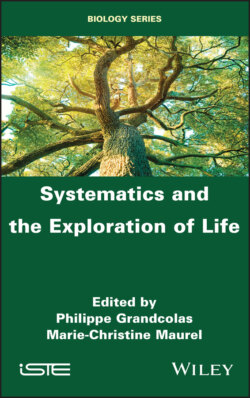Читать книгу Systematics and the Exploration of Life - Группа авторов - Страница 2
Table of Contents
Оглавление1 Cover
2 Title Page
3 Copyright
4 Introduction
5 1 Symmetry of Shapes in Biology: from D’Arcy Thompson to Morphometrics 1.1. Introduction 1.2. D’Arcy Thompson, symmetry and morphometrics 1.3. Isometries and symmetry groups 1.4. Biological asymmetries 1.5. Principles of geometric morphometrics 1.6. The treatment of symmetry in morphometrics 1.7. Some examples of applications 1.8. Conclusion 1.9. References
6 2 Impact of a Point Mutation in a Protein Structure 2.1. Composition 2.2. Folding 2.3. Substitution(s) in protein structures 2.4. Effect on overall structure and function 2.5. Effect on stability 2.6. Effect on the peptide backbone 2.7. Conclusion 2.8. References
7 3 The Role of Taxonomy and Natural History in the Study of the Evolution of Eneopterinae Crickets 3.1. Introduction 3.2. Taxonomy in modern comparative approaches 3.3. A model group 3.4. Contribution of taxonomy for phylogenetic reconstructions and classification 3.5. Contribution of taxonomy to biogeography 3.6. Taxonomic exploration and evolution of species traits 3.7. Conclusion 3.8. Acknowledgments 3.9. References
8 4 Systematics in the (Post)genomic Era: A Look at the Drosophila Model 4.1. Drosophila: a star of genetics but a systematic nebula 4.2. Subspecies: identification of “genomic islands of divergence”? 4.3. Species complexes: congruence between species trees and gene trees 4.4. Supraspecific ranks: phylogeny, genome and morphome 4.5. Conclusion 4.6. Acknowledgments 4.7. References
9 5 Dealing with Multiple Environments: The Challenges of the Trypanosome Lifecycle 5.1. Human African trypanosomiasis, the disease 5.2. Cell biology of Trypanosoma brucei 5.3. Survival and maturation of T. brucei in the tsetse vector 5.4. Adaptations of T. brucei to the mammalian host 5.5. Conclusion 5.6. References
10 6 Challenges Inherent in the Systematics and Taxonomy of Genera that have Recently Experienced Explosive Radiation: The Case of Orchids of the Genus Ophrys 6.1. Introduction 6.2. Speciation in Ophrys: an evolutionary divergence seen as a reticulated continuum 6.3. Current state of knowledge on Ophrys systematics 6.4. Integrative genomics and taxonomy: perspectives and issues 6.5. Conclusion 6.6. Acknowledgments 6.7. References
11 7 Exploration and Origins of Biodiversity in Madagascar: The Message of Ferns 7.1. Introduction 7.2. Madagascar: a complex biogeographical context 7.3. Ferns and lycophytes: an ideal model for the biogeography of Madagascar 7.4. Origins of the lineages of ferns in Madagascar 7.5. The example of Rumohra: dispersions to Madagascar and around the world 7.6. Conclusion 7.7. References
12 8 Mediterranean and Atlantic Algae, a Fraternal Relationship? 8.1. Introduction 8.2. Materials and methods 8.3. Results 8.4. Discussion 8.5. Acknowledgments 8.6. References
13 9 Ontogeny and Evolution of the Hyperorgan of Delphinieae 9.1. Introduction 9.2. Synorganization: a concept, definitions 9.3. Ontogeny and evolution of the hyperorgan of Delphinieae 9.4. The study of synorganization in evolutionary biology 9.5. Conclusion 9.6. Acknowledgments 9.7. References
14 10 Identification of Interspecific Chromosomal Homologies: Chromosomal Microdissection and Chromosomal Painting in Antarctic Teleosts Nototheniidae 10.1. Introduction 10.2. Materials and methods 10.3. Results 10.4. Discussion 10.5. Conclusion 10.6. References
15 List of Authors
16 Index
17 Other titles from ISTE in Biology and Biomedical Engineering
18 End User License Agreement
